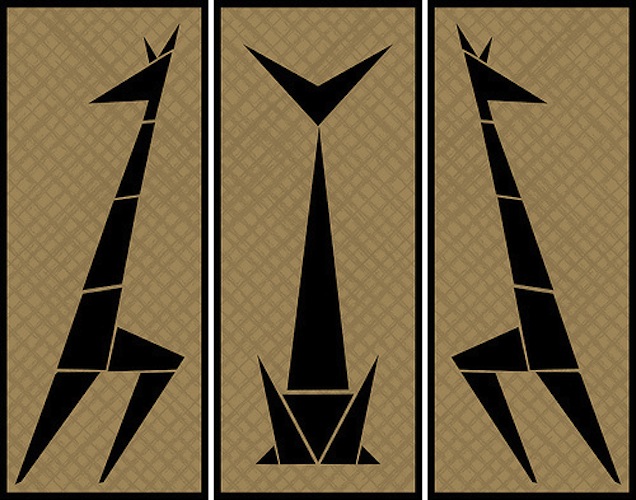TV Review: “Mad Men” Finale — Read the Art?
My conclusion is that Mad Men is abstract, like some of the art in the series.

The art of “Mad Men” — Witco giraffe painting in the home of Peter Campbell
By Harvey Blume
Watched the finale of Mad Men last night and found myself surprisingly tickled by it. Let me say I am no great fan of the series. I’ve half-slumbered through many an episode, wondering: is it me, or does this show just not make all that much narrative or emotional sense? Other times: it’s huh? who are these people? And sometimes: are the NBA finals here yet?
I’d lately come to the conclusion that there is no genuine narrative arc, and that what’s going on is one damn quasi-hallucinatory episode after another.
That remains my conclusion.
My conclusion is that Mad Men is abstract. Like some of the art shown in the series.
There’s been no end of attention to Mad Men and its references to the pop culture of the day, but none of it that I have read talks about the magnificent art used as background or backdrop in most every scene. In fact, if everything were subtracted except for the artworks — edgy, jagged, luminous — on the walls of the characters’ offices and homes, you’d have quite the series.
People could be filled in later, as needed, by the dots.
The story of the art on the wall, however, is muffled by televisual demand of these mad men and women and their storyline, assuming any.
Back to the finale: I do not know why Don Draper hurtles through the Southwest in a race car (he looks good in race car goggles?); why he gets beat up at a bar (the other vets at this shindig fought in Europe, he in Korea?, he’s from NYC, they’re not?)
And why did he give the auto he’d painstakingly repaired to this wayward, thieving Southwest kid (he’d read that famous line by Adrienne Rich who hadn’t written it yet favoring “random acts of kindness”?)
Mad Men does not withstand such scrutiny. But at last it’s over. It’s gone on forever, which is one reason it’s been so hard to discern narrative arc.
In the finale: there’s lots of reconciliation going on.
Mathew Weiner has chosen soft landings. Donald Sterling marries Megan’s mother. Megan’s father, from whom her mother is separated, is a dogmatic Montreal Francophone intellectual, true to the ardent left cause. I must say I missed Megan’s doctrinaire father as the series progressed. He cheered on the riots that tore NYC and other cities apart after the assassination of MLK. This is not to say that I agree with his revolutionism a la Franz Fanon et al, but that I was glad to see it represented. He was a lark, in his doctrinaire way, though according to his wife nothing but a toad in bed.
The finale of the finale: Don Draper at the end of his wits, confronting the option of suicide viewers have long predicted would be his fate. He sits on a California hill, the Pacific in the background, and chants “Om” among assorted hippies, though he alone among them has a cigarette pack bulging conspicuously in reserve in a shirt pocket.
He is saved from suicide by advertising (neither religion nor revolution but advertising). His chants of “Om” are translated into the hugely successful Coke ad he creates, channeling California. His moments of “Om” turn into “The Real Thing,” with everybody on earth wanting it.
It’s funny and astute in its way, about how the urges of the ’60s were co-opted. We all knew that, but here it is on TV, the inevitable machinery of co-optation.
And that, so far I’m concerned, is the point of this somewhat over-celebrated series: the point being is that TV, as per one of its various and expanding delivery systems, is now the text.
Learning to read is learning to watch. Which is my way of getting to a point I come back to time and again as I think about the TV landscape: this is not a television wasteland we’re facing, far from, but an endlessly seductive visual cornucopia, for better and for worse.
Harvey Blume is an author — Ota Benga: The Pygmy At The Zoo — who has published essays, reviews, and interviews widely, in The New York Times, Boston Globe, Agni, The American Prospect, and The Forward, among other venues. His blog in progress, which will archive that material and be a platform for new, is here. He contributes regularly to The Arts Fuse and wants to help it continue to grow into a critical voice to be reckoned with.
